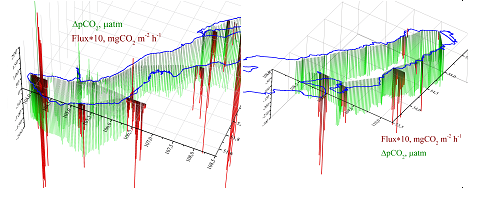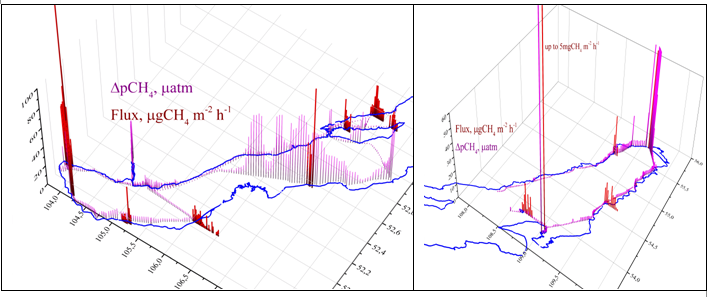International Journal of
eISSN: 2576-4454


Short Communication Volume 2 Issue 2
1VE Zuev Institute of Atmospheric Optics, Russian Academy of Sciences, Russian
2Limnological Institute, Russian Academy of Sciences, Russian Federation
Correspondence: Mikhail V Panchenko, VE Zuev Institute of Atmospheric Optics, Russian Academy of Sciences, Russia
Received: March 03, 2018 | Published: April 5, 2018
Citation: Panchenko MV, Domysheva VM, Pestunov DA, et al. Spatial distribution of the carbon-containing gas fluxes direction in the “water – atmosphere” system in the littoral zone of lake baikal in summer. Int J Hydro. 2018;2(2):195-196. DOI: 10.15406/ijh.2018.02.00068
Earlier we performed all our multi-year investigations of the gas-exchange processes at single measurement site (Baikal Atmospheric-Limnological Observatory, BALO) in the littoral of Southern Baikal and, therefore, the main conclusions are based on these multi-year data, so the problem inevitably arises on applicability of our conclusions and estimated for all littoral zone. Measurements of the spatial variability of the characteristics of this process in all littoral zone of the lake were carried out in 2014 – 2017. The partial pressure of carbon dioxide and methane in the near-water layer of the atmosphere were recorded from onboard the research vessel “I.D. Papanin”.
Keywords: gas fluxes in the “water-atmosphere” system, methane, carbon dioxide, Baikal
The observed climate changes and increase of the content of carbon dioxide and methane in the atmosphere,1‒3 which are both greenhouse gases and the basis of the carbon cycle in nature, dictates the need for detailed study of the carbon cycle in the “water – atmosphere” system for the natural complexes on different scales from global to local.3 The vast territory and variety of natural complexes of Siberia, which is considered in all scenarios as one of the most important regulators of the carbon cycle in the Northern Hemisphere2‒6 requires careful study. Undoubtedly, Lake Baikal is one of the natural objects of world significance in Siberia.7 Previously, the main features of seasonal and diurnal behavior of the concentrations of dissolved gases, biogenic elements, amplitude and direction of the CO2 fluxes were determined from the data of our multi-year measurements in the coastal zone of Southern Baikal at the Baikal Atmospheric-Limnological Observatory (51°54¢N, 105°04¢E).7,8 An empirical model of the diurnal behavior of the fluxes and partial pressure of carbon dioxide in water was proposed for the open water period.9 Obviously, applicability of the results obtained at single observation site for the littoral zone on whole requires additional study in order to estimate the spatial distribution of the process components (first of all, prevalent flux direction). To solve this problem, we organized measurements of the spatial distribution of CO2 and CH4 in summer in the littoral zone of the lake (Southern Baikal in 2014, Northern Baikal in 2016, and Middle Baikal in 2017).
The flux of СО2 and СН4 in the “water – atmosphere” system can be calculated by the formula:
(1)
Where , РСg, pСg is the partial pressure of carbon dioxide (or methane) in the surface water and the near-water atmosphere, respectively, k is the exchange coefficient dependent on the wind velocity. The value DРg determines the sign of the measured gas flux, and we use it for description of the spatial pattern of the distribution of the flux direction.
Carbon dioxide
As is seen (Figure 1), negative values of the difference of partial pressure of СО2 in the water and in the atmosphere (sink) are observed in summer practically along the whole perimeter of the lake. One should especially emphasize that the difference of the partial pressures is distributed over the water area quite uniformly. The flux of carbon dioxide to the atmosphere is observed only in closed bays with obvious anthropogenic impact.
Methane
Distribution of the difference of partials pressures of СН4 between the water and the atmosphere is absolutely different from that of СО2. The methane partial pressure in water exceeds its pressure in the atmosphere in all littoral zone (Figure 2). Hence, the flux is directed to the atmosphere, and all littoral zone is the source of emission of methane into the atmosphere. The most noticeable enhancement of the methane concentration in water was recorded when approaching to the coastal line and, as a rule, the most significant increase was observed near the river mouths and bays.

Figure 1Spatial distribution of the difference of partial pressures of carbon dioxide in the surface water and the atmosphere dР = Рwat - Рatm (green columns) (negative value means the sink from the atmosphere to the water surface); СО2 flux according to the data of chamber measurements at some sites (red columns); (A) Shows the distribution over Southern and Middle Baikal; (B) Shows the distribution over Northern Baikal.

Figure 2 Spatial distribution of the difference of partial pressures of methane in the surface water and the atmosphere dР = Рwat - Рatm (positive value means the emission into the atmosphere from the water surface); СH4 flux according to the data of chamber measurements at some sites (red columns); (A) Shows the distribution over Southern and Middle Baikal; (B) Shows the distribution over Northern Baikal.
With respect to the estimation of the carbon balance in the “atmosphere-water surface” system, let us note that comparison of the difference between the partial pressures DРСО2 and DРСН4 and the total estimate of their fluxes (in terms of carbon) shows that in summer, in the littoral zone of Baikal, the sink of carbon from the atmosphere caused by the fluxes of carbon dioxide is much greater than its emission from the water surface due to methane evacuation.
Authors are grateful to the crew of the research vessel "I.D. Papanin" for their dedicated work and assistance in the research.
None.

©2018 Panchenko, et al. This is an open access article distributed under the terms of the, which permits unrestricted use, distribution, and build upon your work non-commercially.